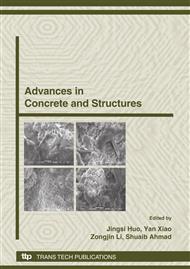p.701
p.707
p.713
p.719
p.725
p.731
p.737
p.743
p.749
The Seismic Response of 1/4-Scale Frame — Supported Reinforced Masonry Shear Wall
Abstract:
The study of this paper focuses on the seismic performance of a new complex tall building-FSRMW (frame-supported-reinforced-masonry-shear-wall).The new structure combines the advantages of RMW (reinforced-masonry-shear-wall) and FSRCW (frame-supported- reinforced- concrete-shear-wall) and have good economic value and extensive use value.Big space can be gained by using the structure, which provide a new appropriate selection for the design of hotel, multifunctional office building and dwelling house with shop at bottom. Substructure pseudodynamic testing were adopted to carrying out the seismic testing of 1:4 Reduced-scale models of FSRMW.Seismic evaluation of this structure has been carried out by substructure pseudodynamic testing of 1/4-scale specimen.The dynamic response of the tested structure under the influence of earthquake excitation is analyzed.The horizontal bearing capacity and the damage degree of the test model are investigated. The testing are cited to illustrate that the seismic performance of the structure(frame-shear-wall-supported reinforced masonry shear wall) is better than that structure(frame- supported reinforced masonry shear wall) and can be satisfied with the design request of 6-8 degree seismic zone.
Info:
Periodical:
Pages:
725-730
Citation:
Online since:
October 2008
Authors:
Price:
Сopyright:
© 2009 Trans Tech Publications Ltd. All Rights Reserved
Share:
Citation:


